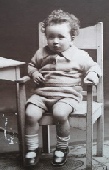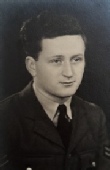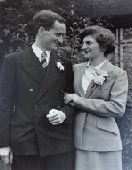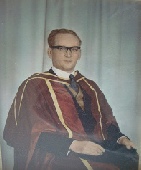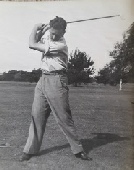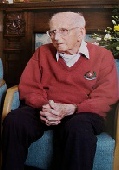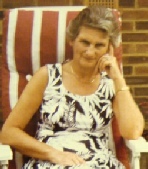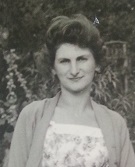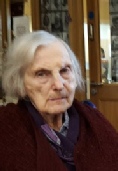Arthur William (continued)
After the First World War began, my father volunteered to join the army and started his service as Private P.S. 9520 in the 8th. Royal Fusiliers on 27th November 1915. He went to France in April 1916 and was there in the first instance until November 1916, when he was wounded in the arm during the latter stages of the battle of the Somme. The War Records at the Public Records Office, Kew, show that the 8th. Royal Fusiliers were positioned N. of the Somme region, near Bethune, during the period April-June 1916, and moved into an intermediate line N.W. of Albert just behind the main Somme offensive commencing on 1st July 1916, (On the first day of the offensive alone, British casualties numbered 57,540. A photograph of a typical attack Is shown in Figure 12). The 8th. Royal Fusiliers were part of the 36th. Brigade, 12th. Division, which attacked Ovillers (see Map 6), right in the centre of the Somme offensive on 7th July 1916, when the 8th. Royal Fusiliers were the first of the three assaulting battalions. The 8th. battalion was on the right and the plan was to take Ovillers from the S.W. flank. The bombardment started at 4.30 a.m. and at 8.26 a.m. the two leading companies crawled over the parapet and lay in the open. The weather was bad and the fumes of the gas shells were blanketed in the hollows of the ground and formed a death trap for many who fell wounded. There was severe fighting and the battalion gained two enemy trenches by the end of the day, their strength being reduced from about 800 to 160, a large proportion of the casualties being wounded, an appalling cost! For a time the final objective was in the 8th. battalion's hands, shortly after noon the Fusiliers were in Omiwers and the Brigade held half of it on a N-S. line. Despite the enormous losses they held on until relieved next day. the battalion was alternately relieved, rested, and then sent back with reinforcements to the front line. Their next big attack was on a trench to the N.W. of Pozieres on 3rd August 1916, which was taken with hand to hand fighting at the expense of 150 casualties. Until the end of September, there were various raids, trench digging, patrols, etc. and on 1st October 1916 the battalion proceeded to the front line just in front of Flers, where they relieved the 26th. Durham Light Infantry. They were subjected to much shelling and had some casualties (110 wounded - 17 killed) during the next 5 days, together with cases of shell-shock, due partly to their exposed positions with only one dug-out in this sector and to the necessary digging of a new trench, which was finished on October 7th, in front of the existing front line. The main attack here - known as the battle of the Transloy Ridges 7th. to 20th. October 1916 - occurred at 1.45 p.m. on 7th October. the first objective being a line in Bayonet Trench and the second being e line in Barley Trench. The positions of these trenches and the existing front line are shown In Maps 7 and 8. The attack on 7th October was unsuccessful owing to the very heavy casualties suffered from the German' machine guns and artillery, and also to the fact that an enemy relief was taking place at the time, with the result that the enemy was at double strength in this part of the line, A few men of the 8th. battalion who got into Bayonet Trench were overwhelmed. At the end of the day there were 37 killed, 116 wounded and 99 missing. As my father was wounded during 8th October 1916, it seems probable that it was during this attack on Bayonet Trench that he received his injuries. The battalion was relieved on 8th October 1916 and received a message from Brigadier General Boyd Moss as follows:- “Will you please thank all ranks of your battalion for their magnificent gallantry displayed yesterday. They advanced steadily under very heavy fire, which only the very best of troops could face, Though unfortunately unsuccessful, their gallant conduct has added to a fine reputation which you have already won for yourselves".
I remember horrifying stories that my father told me about his experiences during the First World War, including the rat-infested trenches, being marooned in a shell hole in no-mans-land with a dead German. the lice, the mud and the squalor. He was sent back to England to recuperate after his wounding, and whilst In England he heard that Army personnel could apply to become officers via an officers training course, provided they could satisfy certain conditions which included having had a school education, which he did not have. However, he went to the Headmaster of Shalford school who agreed to sign his application form, with the implication that the school was a Grammar school. The form was accepted by the authorities, and my father was eventually commissioned as a 2nd. Lieutenant in the 5th. Battalion of the Lincolnshire Regiment on 29th January 1918.
The 5th. Lincolnshire Regiment went out to to the Western Front with the 177th. Brigade, 59th. Division, on 23rd February 1917, transferred to 30th. Division on 28th May 1918, and to the 198th Brigade 66th division on 21st June 1918. They were in the area near the Belgian border between Bethune and Lens. During March 1918 there was shelling and some gas shells were used. During April 1918 the battalion was attacked by fever - 44 cases on the 21st. of April, 23 more on the 23rd. of April. They were visited by ADMS and Army Medical Advisors who concluded that "the fever attack was believed to be a type of influenza to which the men became particularly susceptible owing to their recent exposure to gas".
During July 1918, the battalion was in the Gorre sector (position shown in map 9), about three miles N.E. of Bethune, and the records of July 19th. state "The weather was stormy and the enemy artillery exceptionally quiet, 2nd. Lieutenant Girdler and 2nd Lieutenant Giles both carried out very good daylight patrols and were complimented on their work by the General Officer Commanding." The records of 7th November show the war nearing its end when they were on the W. side of the Petit Helpe river and the battalion crossed the river on a makeshift bridge, helped by civilians from the other side, and state "The civilians were mad with delight and did all they could to help us across. When our men reached the other side, they were immediately surrounded by the civilians who persisted in shaking hands with everybody. " Hostilities ceased on 11th November 1918.
After the war, my father stayed in France with his Regiment for some time and he was responsible, amongst other things. for escorting parties of German prisoners back to Germany. He told me that when carrying out these duties he had to ride a horse. He was promoted to 1st. Lieutenant on 30th July 1919 and held this rank until he was demobilised on 30th September 1921.
During the war, my father and his brothers Basil, Charles and Cecil often visited their sister Alice and her husband Christopher (Joe) at 459. Fulham Road, S.W.6. on their way home on leave. Here they were often de-loused, etc. prior to returning to their home in Shalford. Alice was very fond of her brothers and in her eyes they could do no wrong. After leaving the Army my father and his brother Basil spent some time going round the racecourses all over England, using 489 Fulham Road as their base. They worked a system in which they always backed the favourite horse to win in the first race. If this lost, they backed the favourite in the second race to win £2 plus the lost stake in the first race. This procedure vas repeated until a favourite won, when they reverted to the beginning again. Once or twice they got very near to losing ail their savings. but managed to exist Iike this for a time until they saw the "red light” and decided to seek more normal occupations. It was during this period that Dad and Uncle Basil met their future wives. I understand that they met my mother and Auntie Kit (Louisa and Catherine Gorham) on Putney Bridge in London during the time that they were at Fulham Road, and the Gorham sisters were at Fleming's (Frascati’s?) restaurant in London, having moved from Felixstowe just after the war. Subsequently the two brothers married the two sisters.
After their time on the racetracks my father and Uncle Basil started work. My father first worked at Worth's, an antique shop in Regent Street. and then at a firm called Shipley Main. My mother and Auntie Kit went to live at 489, Fulham Road for a short time prior to their marriages where my mother slept in one bed with my cousin Kath (Alice’s daughter) Auntie Kit slept in another bed all in Kath's room.
Uncle Basil married Catherine Gorham on 14th June 1924. My father married my mother Louisa Annie Gorham on 2nd August 1924 at St. James Church, Fulham. My parents continued to Iive at 489, Fulham Road after their marriage, where they had a bed-sitting room in the front room in the basement, in what was later the living room. and I was born on 31st October 1925. Later on we moved to Radipole Road, Putney, and then in to 22, Court Way, Colindale, London, N. W. 9. where my sister Peggy was born on 7th March 1930. At that time Dad ran an antique shop in St John's Wood, London, the travelling into London being made much easier with the recent extension of the Northern Line Underground railway to Edgware via Colingdale.
Life in the 1930's was becoming increasingly difficult with the recession and mass unemployment. My mother had an operation for gallstones in 1932, and my sister Peggy and I stayed with our Auntie Allie (Alice) Uncle Joe (Christopher) at Fulham Road until Mum had recovered from her operation and had been sent to a convalescent home in Swanley, Kent. There was no National Health Service in those days, and I remember my father having to meet the Lady Almoner at the hospital in order to discuss how much he could afford to pay towards the cost of the operation. Peggy I were well looked after by Auntie Allie and Uncle Jo and three daughters, Kath, Glad and Vera.
Later on, my father's business at St.John’s Wood became bankrupt and he had to pool all his resources to try to save it, unhappily without success. He was then unemployed for about two years, during which time he had to delay payments on his mortgage and we had to economise in everything - a difficult period. In order to make things easier, my mother took in lodgers. I remember first a Mr. MC. Lean, then two Scottish girls Chris and Jean, then Mr. and Mrs. Welbourn and their daughter, and finally an R. A. F. Officer from Colindale Aerodrome, F/ L Jelley and his wife. After his two years of unemployment, Dad was offered a Job by the father of a friend of mine, John Demalne, who also lived in Court Way, Thus, shortly before the outbreak of the Second World War in 1939 my father became an accountant with a firm called Guymers dealing with cattle and other animal feedstuffs. During the early part of the war the firm was evacuated to Gerrard's Cross. Buckinghamshire, and he travelled there every day from to Eccleston Square, Colindale. Later the company returned to London, Victoria, with offices on the 3rd. floor of an old mansion there. After the war the firm moved to Richmond in Surrey.
During the war, when we were still living in Colindale, many high explosive bombs, incendiaries, flying bombs and mines were dropped in the Hendon area during the German air raids. We often had to take shelter at these times in the Anderson shelter which had been built in the garden. My father and I were on a rota of fire-watchers for the road in order to bring rapid assistance in the event of any fires started by incendiaries, but luckily there were no bombs dropped in our road during the war.

